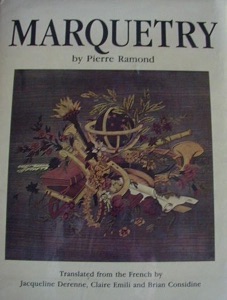Some Marquetry History

arquetry, can be explained in many ways, most are confusing. It is
sometimes referred to as inlay or intarsia. As defined by Pierre Ramond, the
professor emeritus of l’Ecole Boulle in Paris, France marquetry is the art of
making pictures and geometric designs with slices of colored wood, shell and other precious materials. It is a popular technique for decorating the smooth surfaces of pieces of furniture as well as a versatile means of creating expression. Marquetry is an ancient art, but its techniques are readily applied in contemporary work. Pierre Ramond, author of Marquetry, our bible, also collected and published Masterpieces of Marquetry, a three volume set. It contains the classics--the photo above is in volume III.


In my opinion the uniqueness of the French method of this art is the result of the use of the chevalet de marquetry. This is the saw system that cuts the pieces and background. It was introduced to the marquetry world in the 19th century. Throughout this site you will see examples where this saw stands alone in certain cutting techniques. The 2/0 blade that is housed in the saw frame cuts a swath (kerf) 0.024 inches in width. So it is easy to imagine the versatility of this instrument. There is one project I’m doing that uses a much smaller 5/0 blade. I’m using it to cut annealed brass, pewter and faux tortoiseshell at the same time. Other cutting methods use razor blades, hand saws (fret saws), chisels, etc. The chevalet is able to make numerous copies since each cut is exact. This will be explained later in the inventory section.
The taste for inlayed furniture that dominated the 18th century
originated in medieval Italy and swept into southern Germany and Flanders. At the beginning of the 16th century this art was introduced

Into France by the oligarchy connected to the Royal Court. In 1620 marquetry reappeared in a style of Italian origin. German marqueteurs invented a method called tarsia a incastro where 2-3 sheets of veneer were placed one over the other and then were cut in this stack following the line in the drawing (pattern) that was glued on the top of the packet. This method was perfected by Andre-Charles Boulle (1642-1732), the famous cabinet maker to King Louis XIV, the ‘Sun King’. Now you know that when someone says that this is a “Boulle” table or chest, it was by Andre-Charles Boulle’s technique that he improved that is coined by his name.